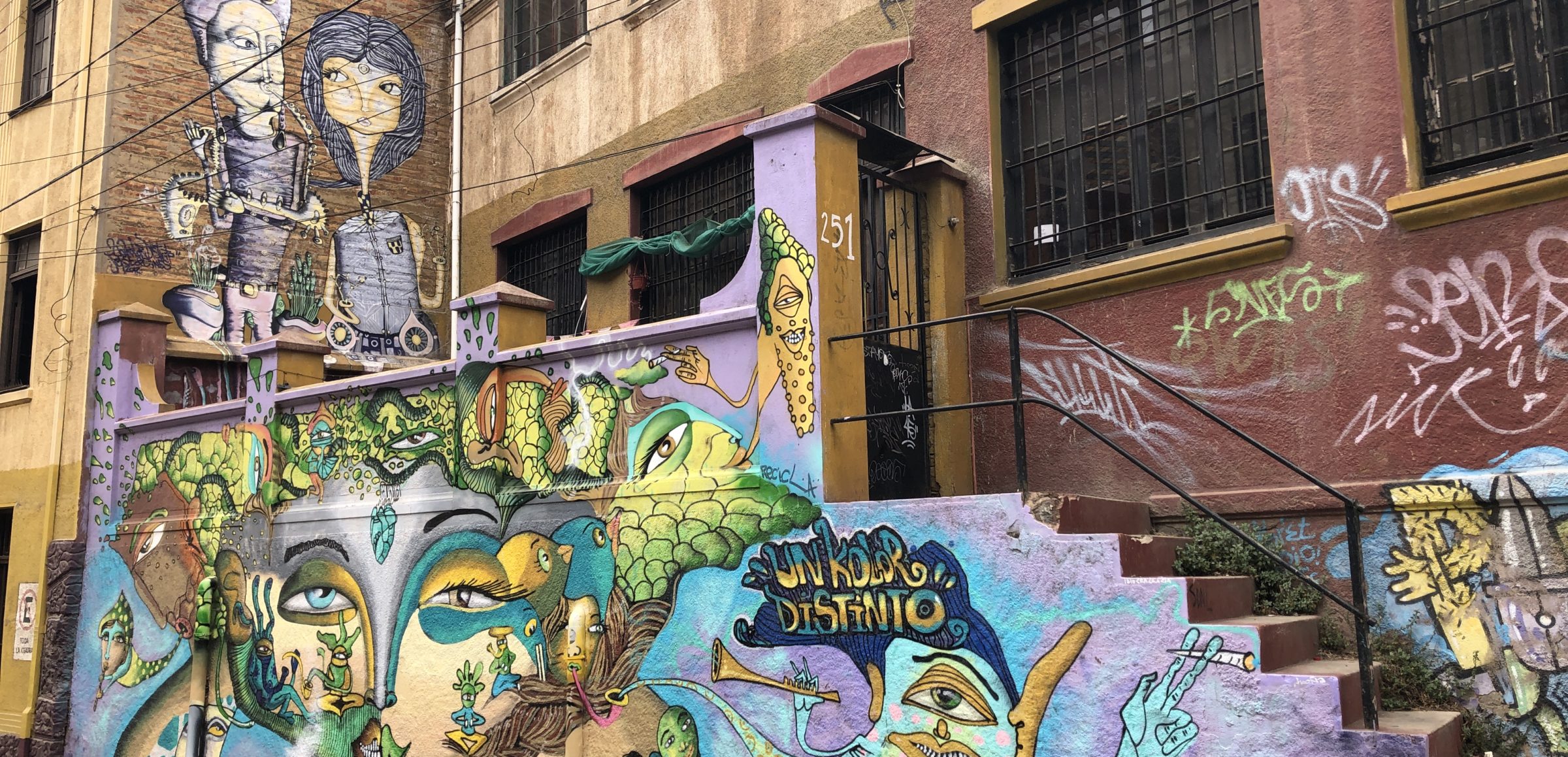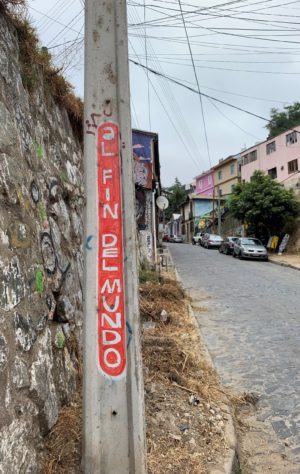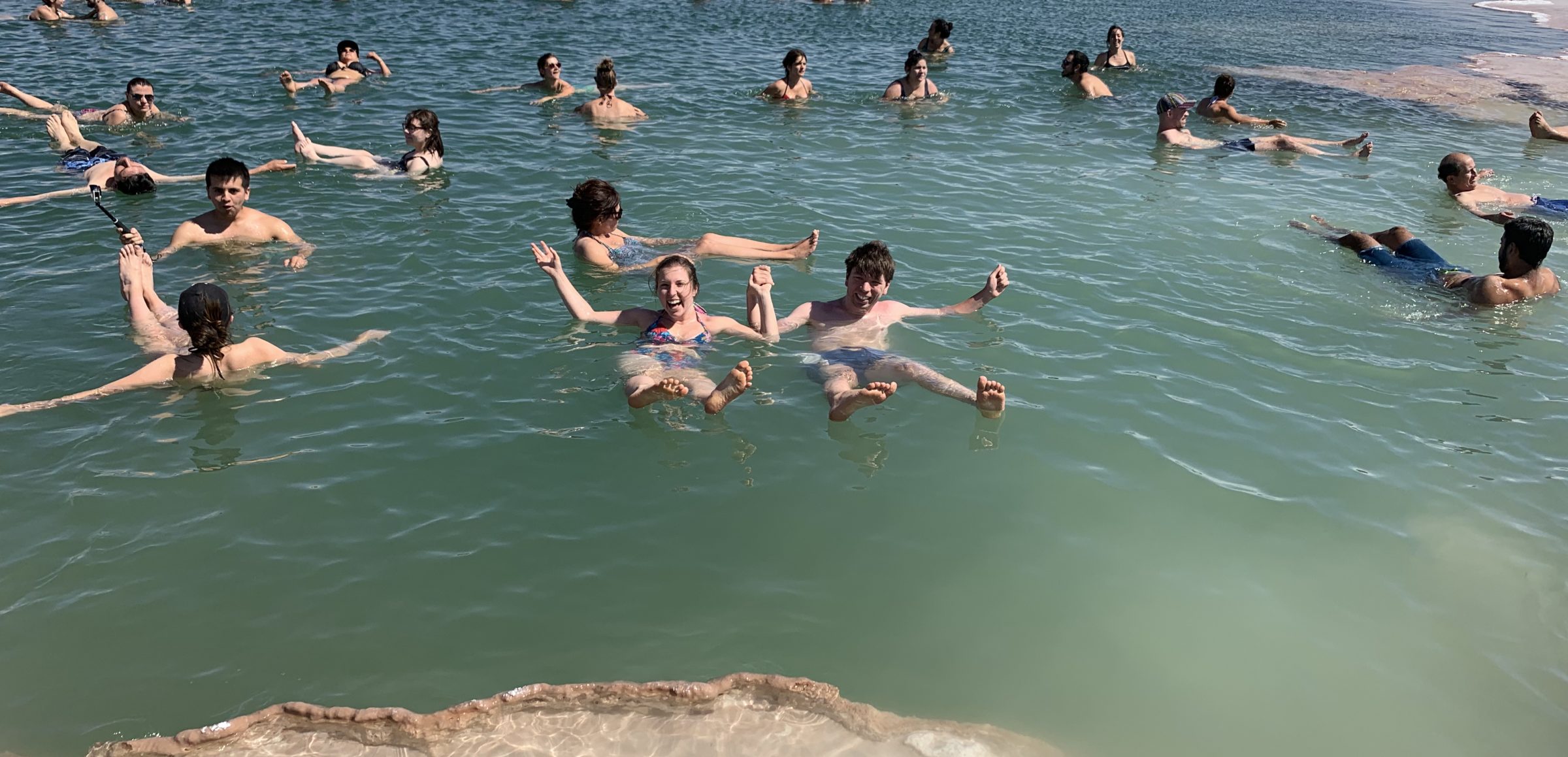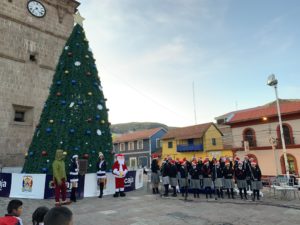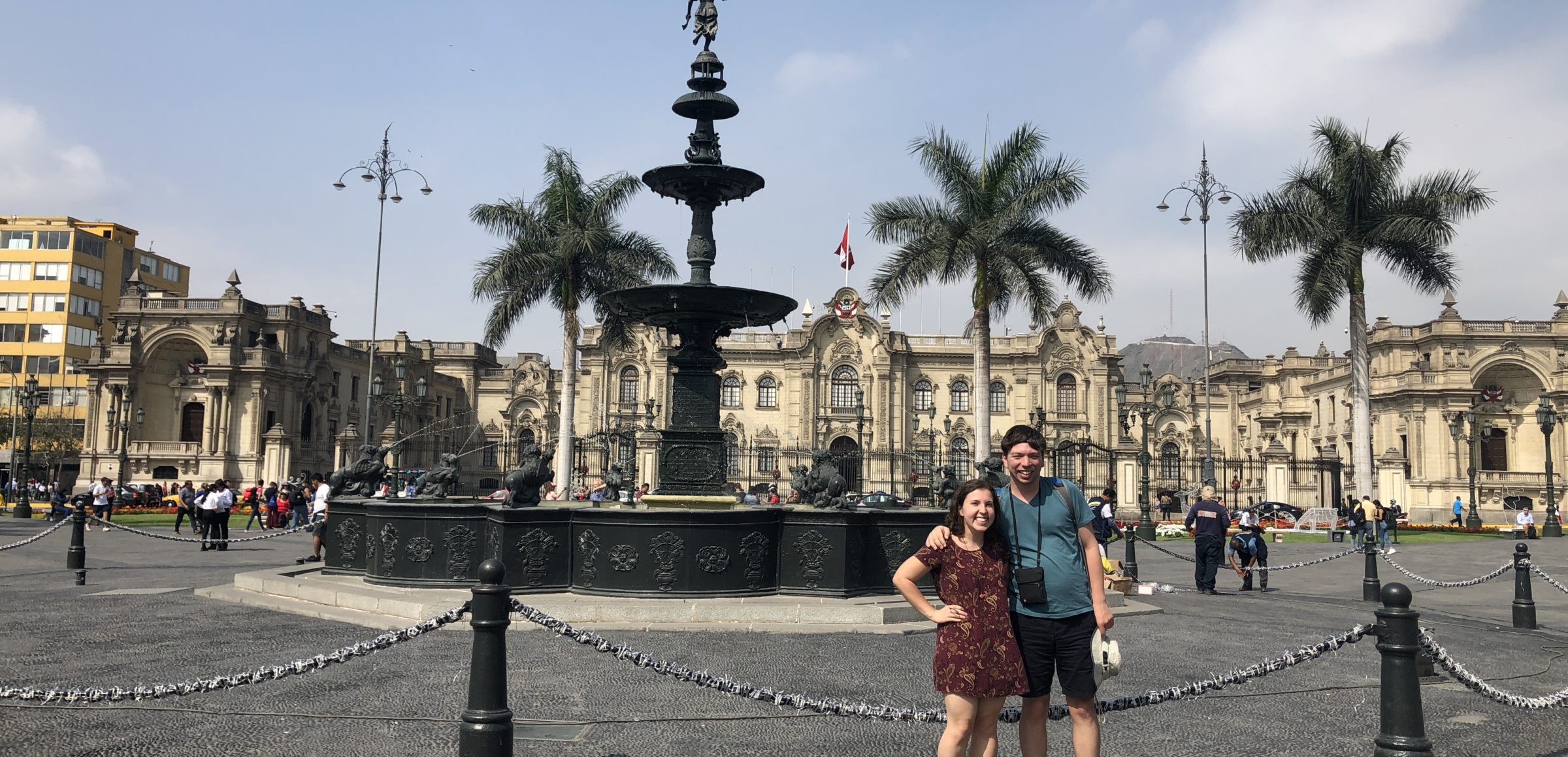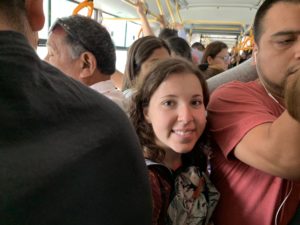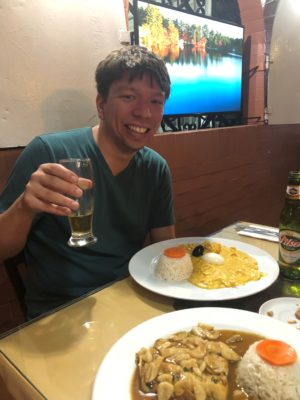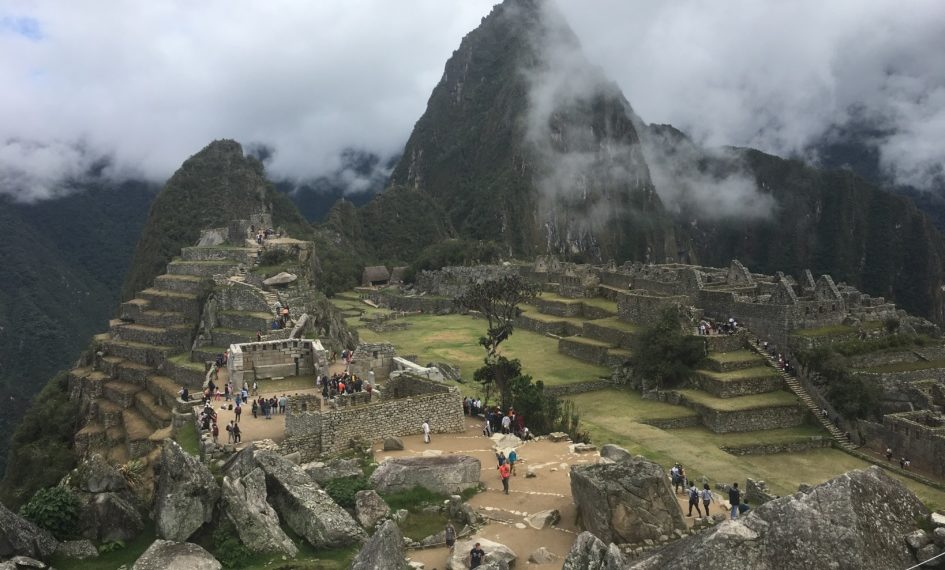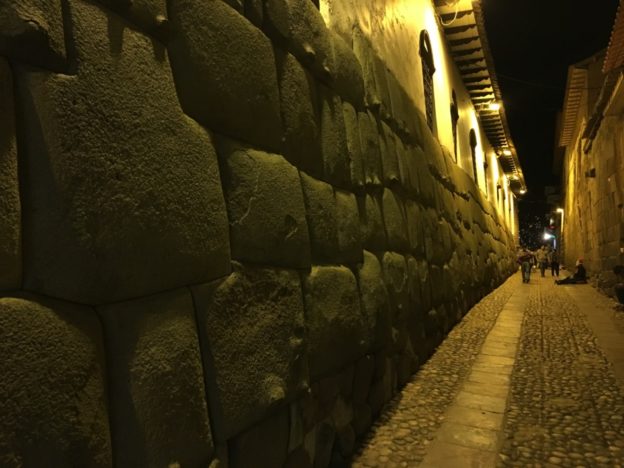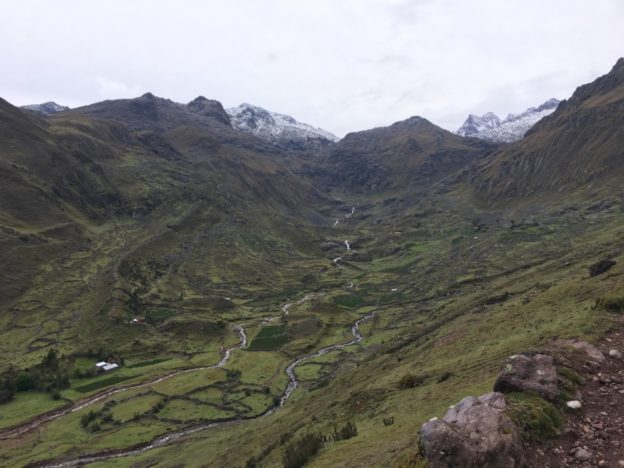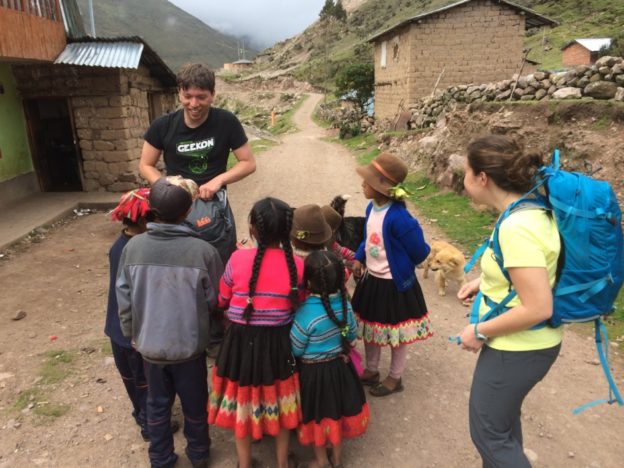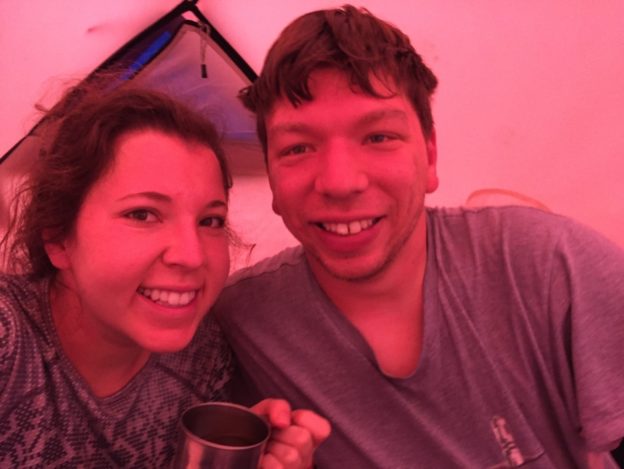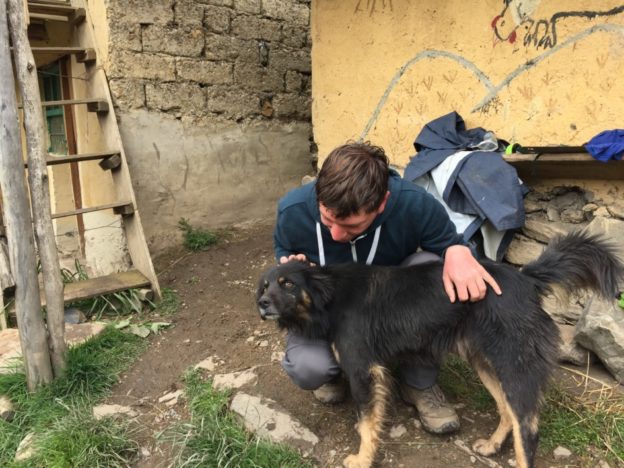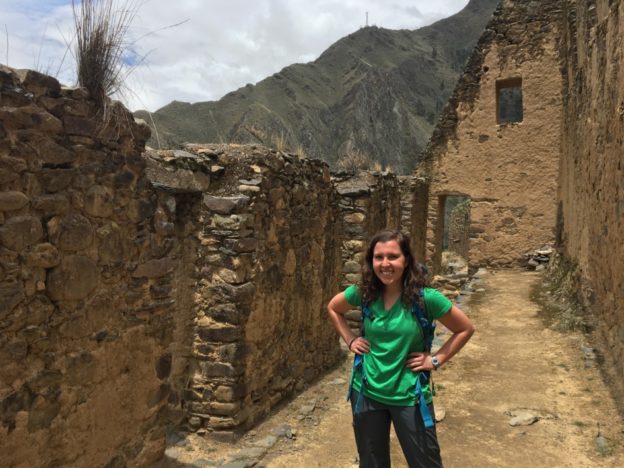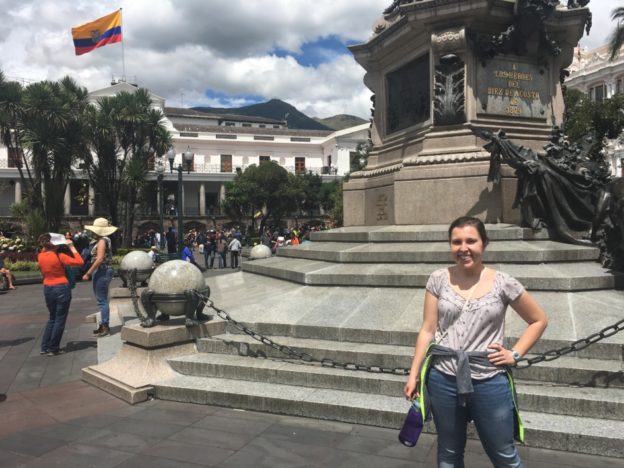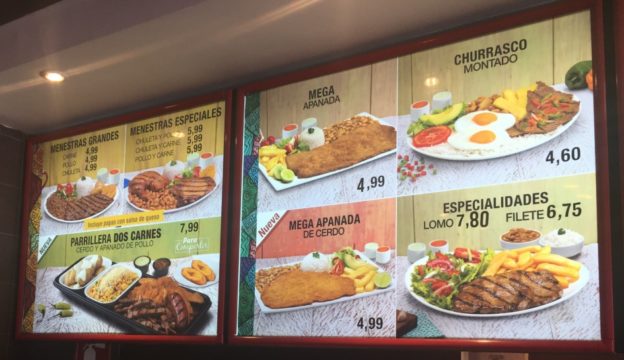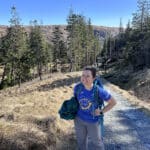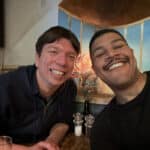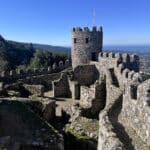A brief post from Valparaíso, where we’ve been staying for a few days and which is about two hours by bus from the capital Santiago. An important port until the opening of the Panama Canal in 1914, the touristy bits of Valparaíso are now purpose-built for Instagram, with artistic murals adorning walls and walls of colourful buildings in the hills which rise up over the sea.
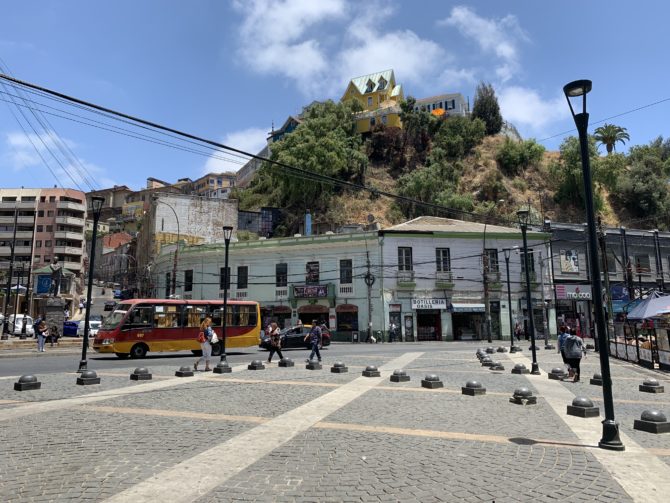
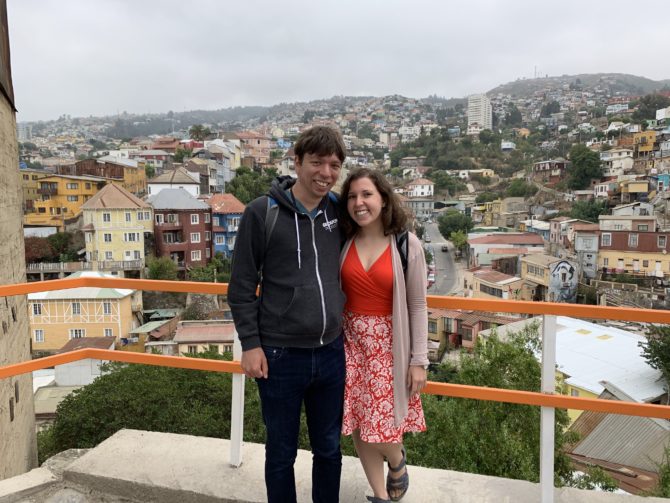
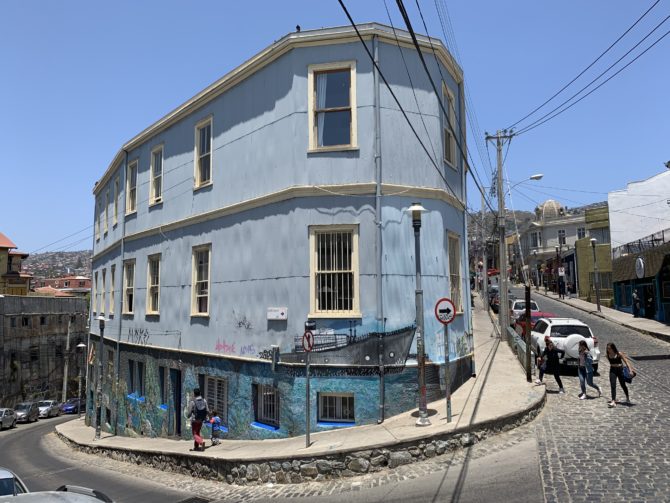
The ‘offbeat’ walking tour we chose, from Tours 4 Tips, was led by the best guide we’ve had on our travels so far. It started with am unplanned and bracing introduction to the non-tourist side of the city as we all felt the residue of the tear gas used by the police yesterday against striking port workers. The strikers’ key demand is to include temporary workers in collective bargaining agreements, and last night this escalated into a violent confrontation. We saw some evidence of damage and broken windows, but it was obviously impossible to tell whether tear gas was really necessary and if we should be calling this a ‘riot’ or not (as our guide did). Suffice to say, walking around the hilly areas felt totally safe, but down by the port area it stung in the throat.

We also saw the former prison on Cerro Cárcel (now a cultural centre) where political prisoners, among others, were held and tortured during the Pinochet dictatorship. (And, side note, our guide pronounced the ‘t’ in Pinochet so I am now going to follow suit.) Altogether, the walk was a reminder of the different sides of Chile – past and present – as well as a perfect way to see a beautiful and bohemian city.
On a random note: in one of the supermarkets here I found Waitrose strawberry jam, which was a little baffling. Of course I bought one anyway.
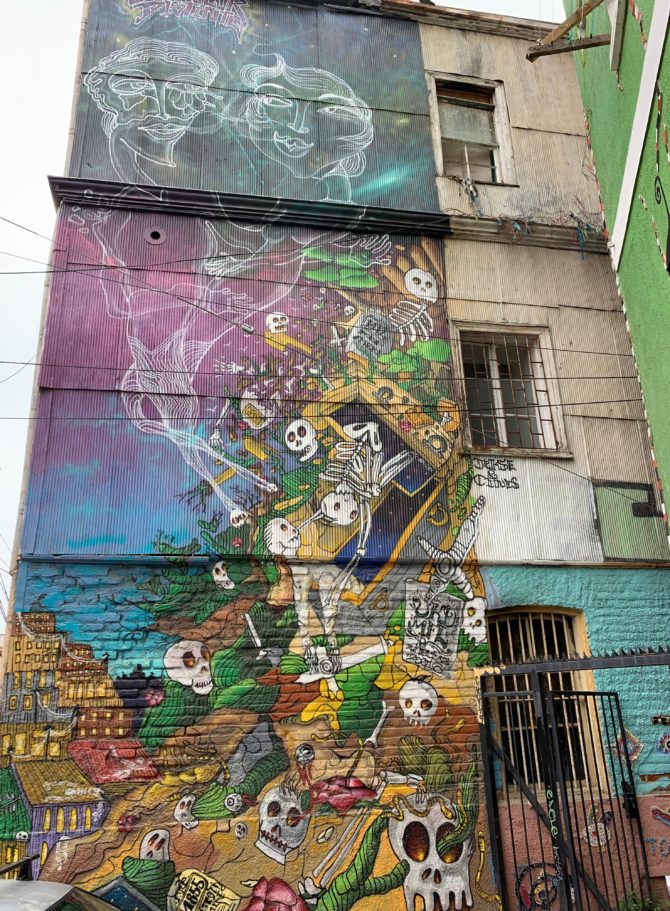

Since I last wrote, we enjoyed our final night in Puno – I particularly enjoyed the children’s choir bedecked in Santa hats and the pizza place playing the video of Moldova’s 2017 Eurovision performance – before boarding a bus to Tacna, which is right by the border with Chile. The weirdest part of this bus journey was the surprise entrance of competing bread sellers in the middle of the night… and I could have sworn that one of them was trying to flog a bag of potatoes too.
In Tacna, it was a short taxi hop to the international bus station and then a collectivo (shared cab) across the border to Arica in Chile. I was pretty impressed by the efficiency of the collectivo operation, which runs at a standard tariff and includes a driver to hustle the group through both the Peruvian exit controls and then Chilean immigration controls. These officials sit in the same building, with their backs to each other, at opposite sets of windows. I am really curious what happens if you pass the first but then fail the second.
Ah, Arica. We didn’t choose to spend a day here – it was an artefact of bus timetables, and we suspect that’s the case for most travellers. There’s nothing hugely wrong with it – and indeed I had an excellent breakfast (with a decent cup of tea!) – but we were very happy to be leaving at the end of the day. The real masterstroke (all credit to Randi) was paying for a cheap hostel room so we wouldn’t have to drag our stuff around in the sun. The secondary and surprising masterstoke was that after the hostel owner quoted us a price which we couldn’t yet pay (as we didn’t have any Chilean pesos) she was content simply to take the rest of our Peruvian soles instead.
The overnight bus from Arica to San Pedro de Atacama (operated by Turbus) was my most solid night of sleep on a bus so far, other than our unexpected 3am stop where we were all briefly chucked off so we could take our bags through “customs”. (Customs? We’re still in Chile, guys!) This was on top of having our passports taken away when we first boarded so they could be presented to a police checkout later. The bus company were very good (and reassuring) about the process and everything was duly returned, but it did smack a little of police-statism to have so many internal controls.
So then, after having set off from Puno on Tuesday night, we finally arrived at San Pedro de Atacama on Thursday morning. Situated in the middle of a desert, San Pedro is completely geared around tourists but also has a calm and relaxed vibe. It felt very chilled-out as everyone strolled down the sandy streets of the town centre, and many of the tourists seemed to be from Chile itself. After walking to our AirBnb from the bus station – and being shepherded the whole way by two dogs – we did what everyone comes here to do and booked a bunch of tours and excursions for the rest of our stay.

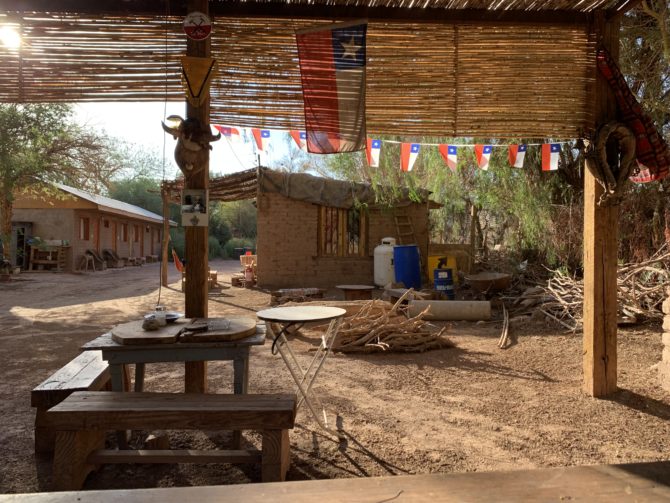
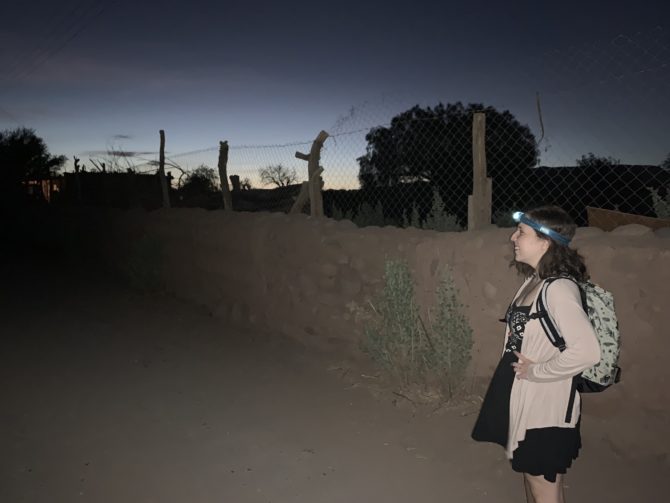
One of the most popular trips is to the Bolivian salt flats (Salar de Uyuni). But Bolivia’s visa costs for Randi’s American passport were onerous, and neither of us wanted another overnight trip at that point anyway. So instead we opted for three half-day trips, all of which (and here my mum would be very proud) involved getting into bodies of water.
Some added excitement was thrown into the mix when we discovered later that our tourist agency was extremely badly reviewed online. Would the buses turn up? Would they turn up and then throw us off a cliff? We worked up some backup plans but in the end everything ran (relatively) smoothly, and so now I present our three waterworlds of San Pedro de Atacama…
Tour 1: Thermal Baths

Our first trip was to the Termas Banos de Puritama, an oasis of warm pools and waterfalls in the middle of a desert valley. Aside from getting a little sunburnt we had a very relaxing morning here, testing out each of the seven pools in turn. The water was pleasantly warm but not piping hot as in some other hot springs, making it easy to stay for as long as time permitted.
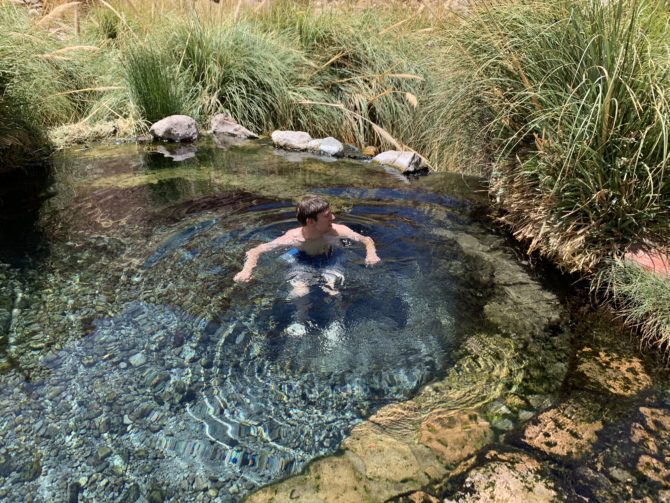
Tour 2: Salt Lagoons
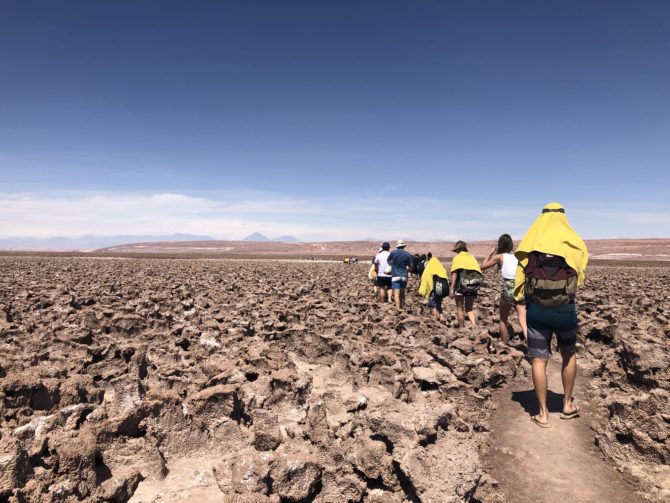
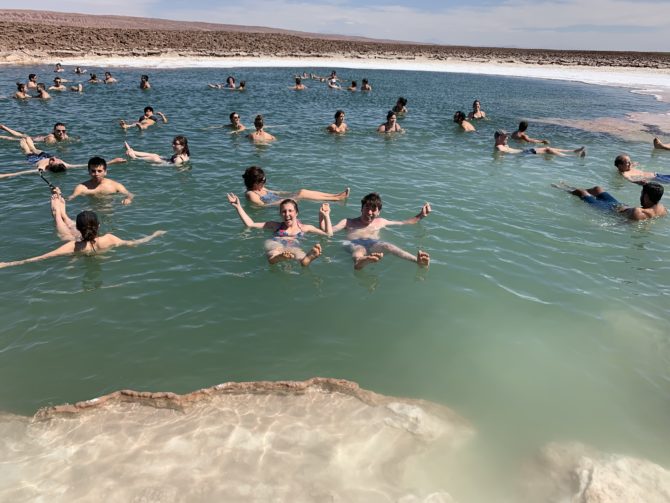
Now this was a totally new – and very cool – experience for me. The Lagunas Baltinache are a series of very salty lagoons, a couple of which are open for swimming. Or, if you prefer, just plain floating… because with so much salt, you are completely buoyant and it is nigh on impossible to sink. I had heard about this phenomenon in the Dead Sea but never felt anything like it before, and it’s a weird feeling to realise that you can just completely stop paddling and relax in the water. This was my favourite trip we did while we were here.
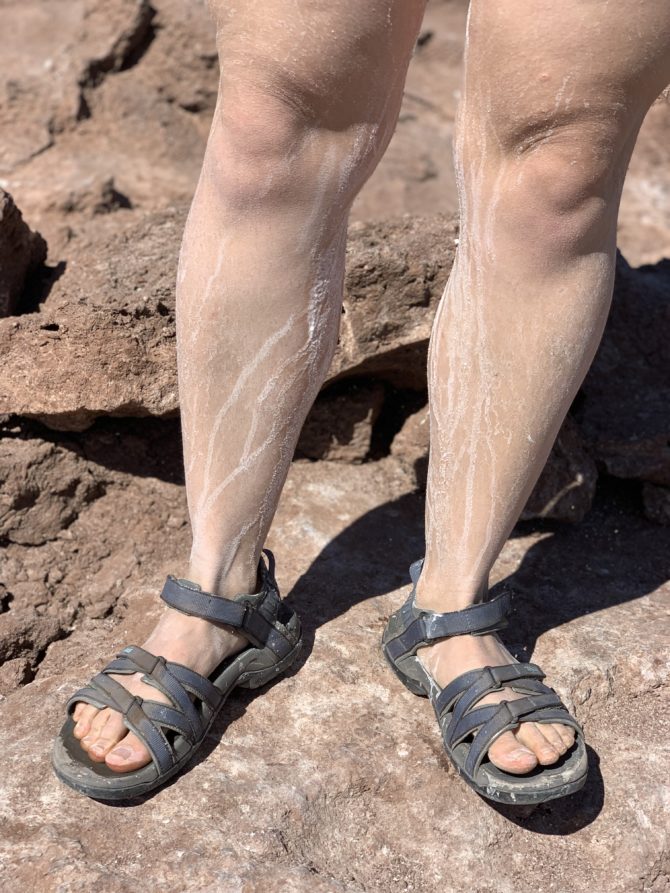

On the way back we had our obligatory vehicle incident when one of the tyres popped and was subsequently chewed up by the unpaved desert road. Cue us waiting in the desert for a while for the type to be swapped out.
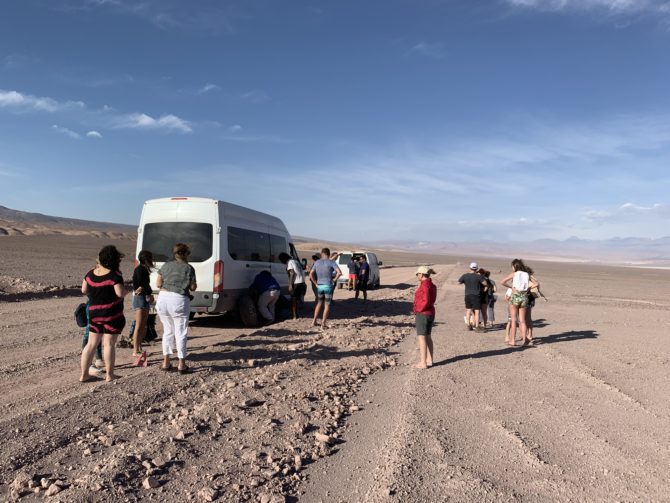
One other disadvantage of these afternoon tours is that you are held hostage to watch the sunset, and out here the sun sets very very slowly…

Tour 3: Significantly Colder Salt Lagoons, Plus Some Jumping
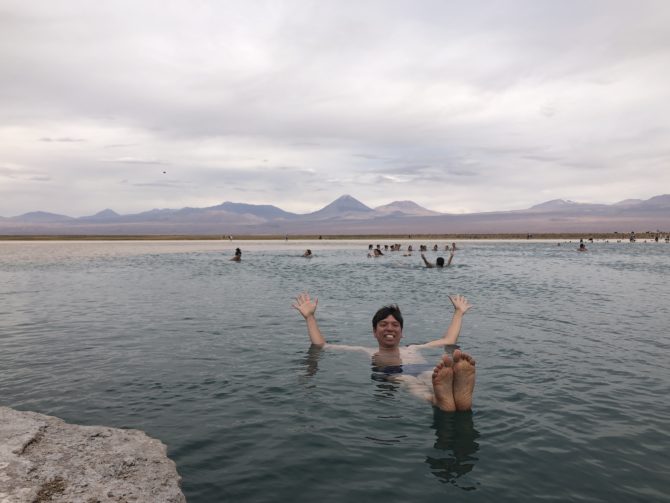
In a slight faux pas, we didn’t realise that Laguna Cejar was also salty and buoyant, so the next tour repeated the same “look, I’m floating!” trick, albeit this time in much chillier water thanks to the overcast sky. But later we moved on to the Ojos del Salar (i.e. the pools you’re allowed to jump into) which I did after watching some other people go first. Finally, we drove to the beautiful Laguna Tebinquiche for another sunset 😉
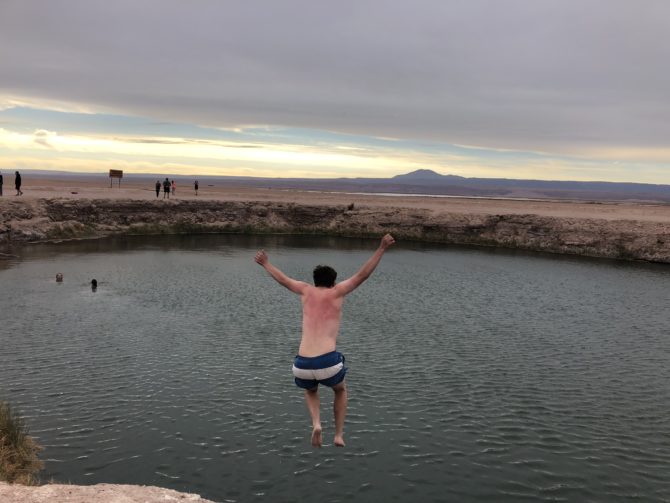
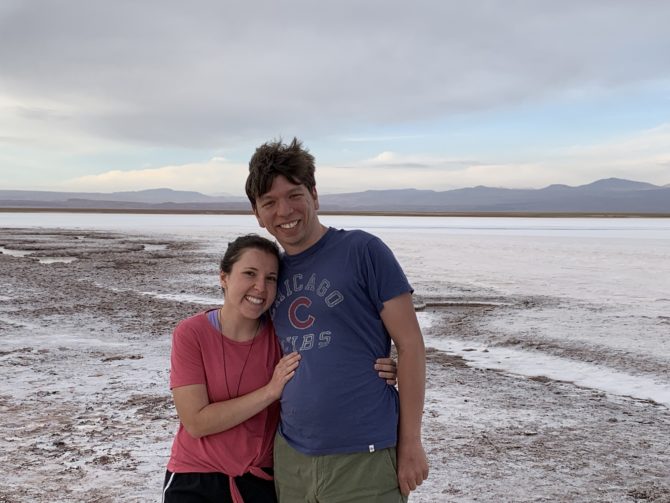
Bonus Tour: Stargazing!
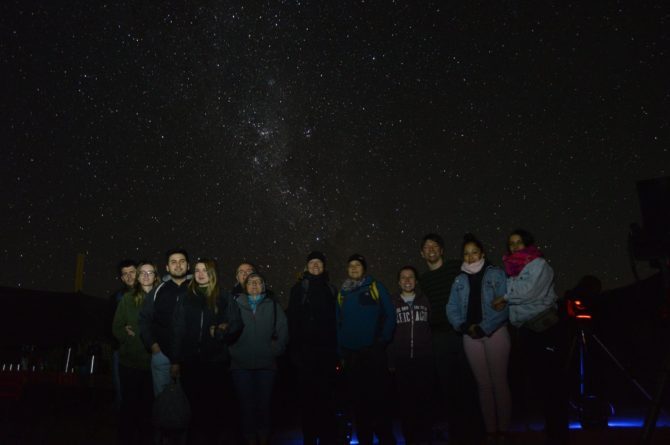
San Pedro de Atacama is also known for its astronomy tours, and even though the only available slot was between midnight and 2am one night we decided we couldn’t miss it. And I’m so glad we did, because it was incredible. I have never been able to see the constellations of Orion and his dog so clearly before, even though – being the Southern Hemisphere and all – they were upside down. After looking at the night sky (and shooting stars!) with our naked eyes we were given warming cups of hot chocolate while five telescopes were readied. Through these we saw a variety of objects: stars, clusters of stars, binary systems, nebulae, Mars… although, and I’m sorry to be very parochial here, the best of the lot was the incredible beauty of our own moon and its cratered surface.
I was very impressed with our guides (one of whom answered my question about planets orbiting binary star systems with the latest research) and overall the night was awe inspiring in the real and true sense of the world. It’s funny how you do think about our place in the universe just by seeing a little bit more of it.
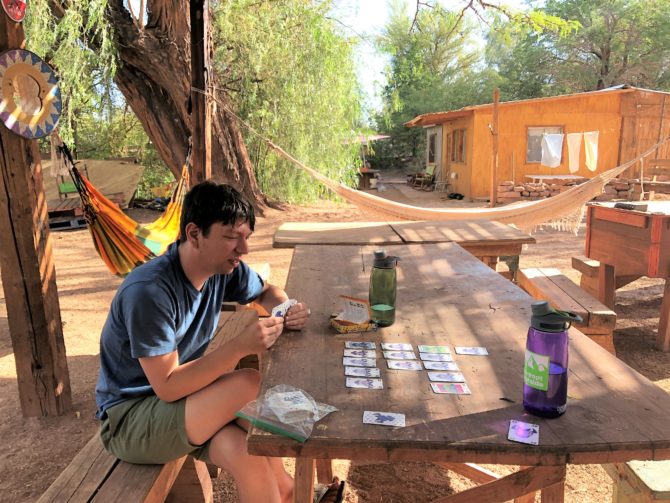
Finally – aside from all of the rushing around on tours, one low-key but equally lovely part of our stop here was the evening where we made dinner and got chatting in Spanish to a Chilean couple staying at our AirBnb. OK, admittedly it was mostly Randi doing the talking but I understood the gist at most points, and it was the first proper in-depth conversation we’ve had with strangers while travelling. For the record, this couple declared that while Chileans are pretty emotionally reserved (“like the British”) we should watch out for Argentinians who are much more emotional. I will bear this in mind for later…
After Lima, our next stop was Arequipa via a short flight. (Airport fast food related side-note: the doughnuts from Dunkin’ Donuts in Peru are actually delicious. I’m unclear why the same can’t be true in the US.) Arequipa is frequently described by guides as Peru’s prettiest city, and although I’m not quite sure I agree (Cusco takes some beating) it is true that the main square was almost serenely calm and relaxed on Friday evening.
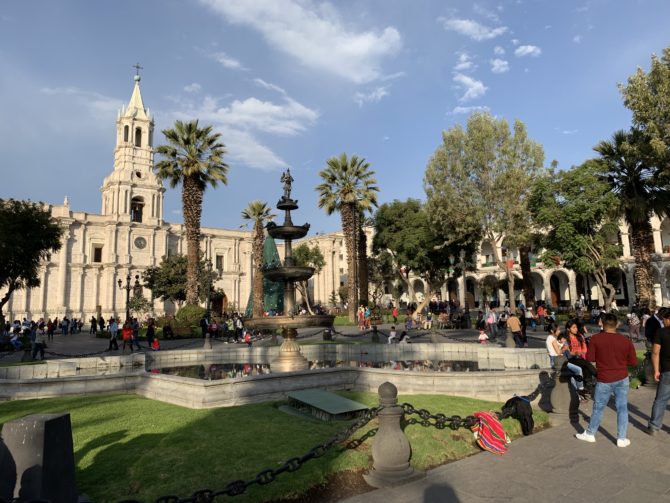
We didn’t spend long in Arequipa, but two of my favourite moments were:
- Randi taking a quick look inside the church (I had to stay outside as I was wearing shorts) and then immediately being barricaded by two giant sets of closing doors signalling the start of mass. I wasn’t sure if I was ever going to see her again, but luckily she found a side exit.
- Having breakfast with football on in the background, and hearing the incredibly excited “GOAAAAAAAAAAAAAAAAL” from the commentator after someone scored. I felt like I had scored bingo on Latin American stereotypes right there.
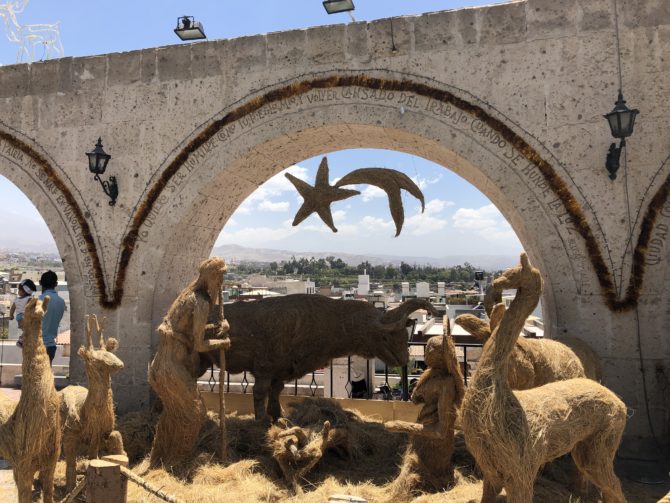
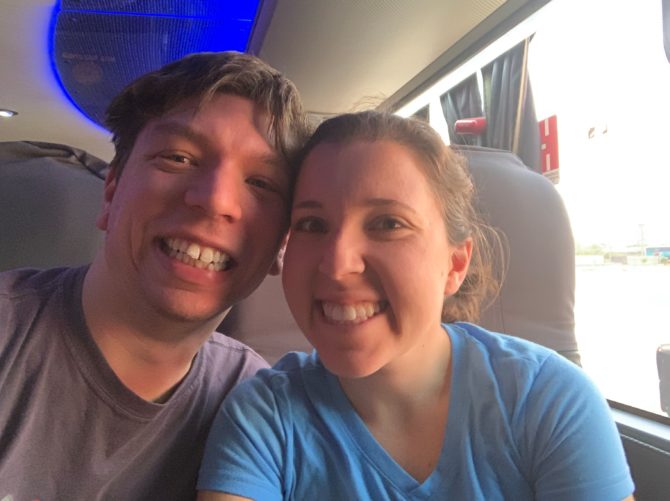
The next afternoon, we set off for Puno and boarded the first of our long distance buses during this trip, after first admiring the very fulsome nativity scene in the Cruz del Sur waiting lounge.
For the bus itself, there’s really two ways to look at things. On the one hand, it was easily the most luxurious bus journey I have ever taken. We were in the VIP section (it’s really not that much more expensive) which had full reclining seats, giving us plenty of room and comfort to lie back, relax and catch up on some podcasts, Dynasties and Would I Lie To You. On the other hand, it’s still a 6-hour bus ride, so I wasn’t sad when it was over and we finally arrived in Puno.
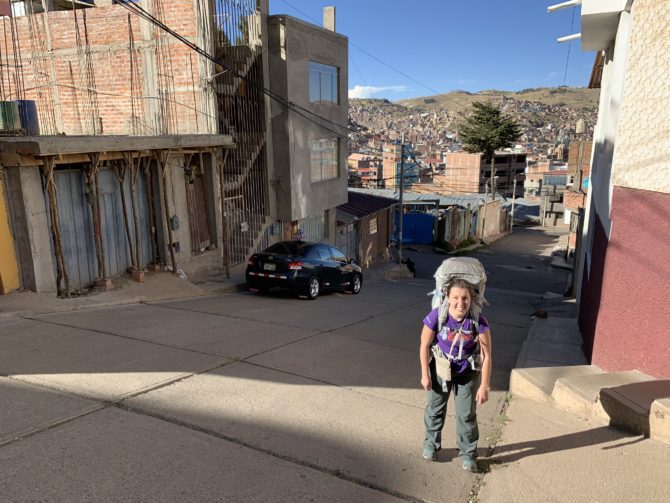
But we need to pause on Puno for a moment, because the next morning we embarked on an overnight tour of Lake Titicaca, the Uros Floating Islands and the islands of Amantani and Taquile. My least favourite part of these tourist tours are the “meet the native people” sections. This was especially problematic on the Uros floating islands, which are very very small, so the whole place is completely enveloped by us tourists taking photos… except these are real people and real people’s homes, so it feels artificial and intrusive. That said, these tiny islands on the lake are undeniably cool – and weird – to walk around on.
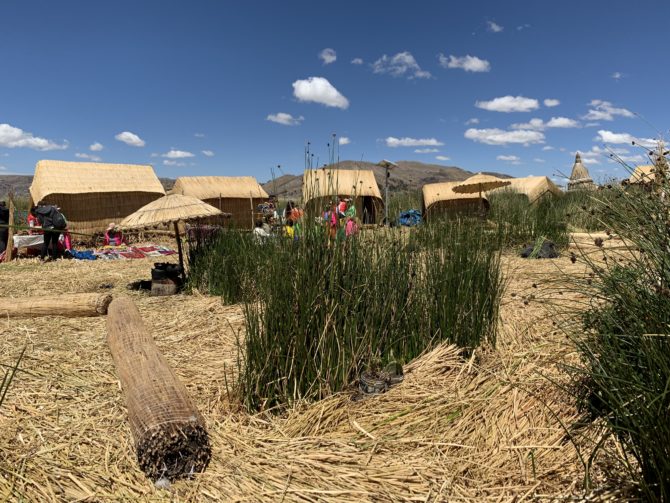
The best part of the tour was our hike on Amantani island up to the peaks of Pachatata and Pachamama, both of which hold the remains of ancient temples and astronomical sites. Prior to this hike our tour group had been divvied up between several host families on the island (which felt a little like getting picked for teams in PE) and had been fed lunch, and as I looked around the table I decided we might be in some sort of reality show preparing for the next elimination round. Well, I didn’t want to be eliminated next, so I grimaced through my initial pain at the steep, high-altitude climb (Peruvians don’t seem to believe in switchbacks) and was rewarded by amazing views of the sunset at the top.
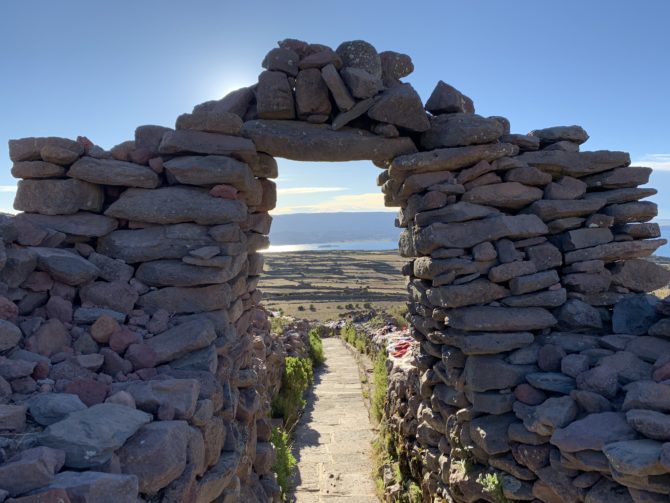
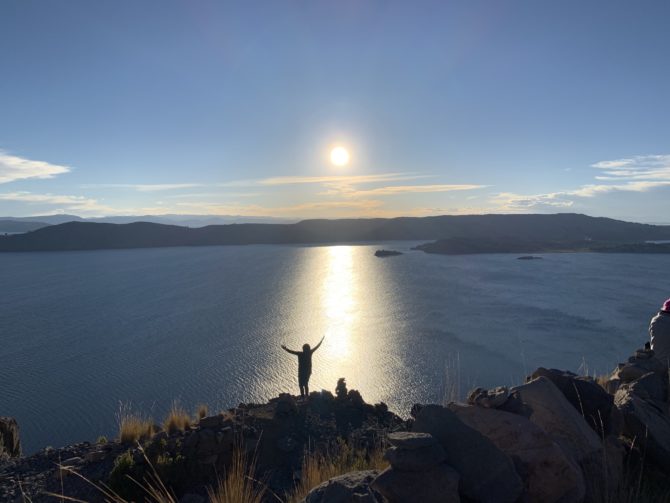
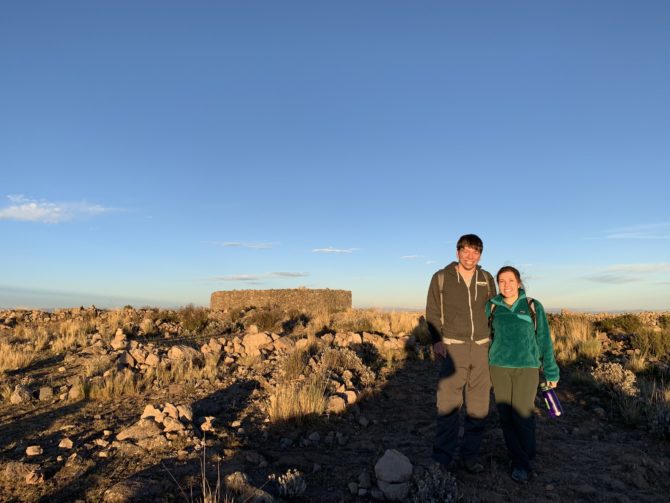
By this point, we were both totally exhausted, and neither feeling 100% in either head or stomach. (Actually, if it hadn’t been for Randi’s miraculous Spanish in the pharmacy that morning, I would have been feeling a lot worse.) So we both opted-out of the “dress up in traditional clothes and go to a disco in the village hall” event, feeling only a tiny bit smug the next morning when we learnt that none of the locals had turned up and the whole thing had been cancelled.
Our final stop was Taquile Island, before heading back over the lake to Puno in the world’s slowest boat. Taquile was certainly beautiful (proof below) although I was increasingly sceptical of the various lifestyle factors which our guide kept claiming resulted in the locals living to “95 to 100 years old”. If that’s the case, they certainly are doing well to manage their demographic pyramid. We also learnt about their somewhat rigid uniform system (e.g. one colour hat for the married men, another for the unmarried men) and I wished I spoke the local language so I could check how well this actually worked out in practice. There are always rebels in life, even on Taquile.

Once we got back to Puno I was incredibly happy to have a hot shower, collapse and cook the pasta and tuna which I’d been carrying around since Lima. (We got told off for trying to use the kitchen in our AirBnb there, and didn’t want our supermarket run to go to waste!) Randi was originally a little bit suspicious of the accommodation I had booked, for minor reasons like (a) no-one else seemed to be staying there, (b) we had to change rooms because they couldn’t find a key to our original room and (c) the bed slats started to fall out of the bed if we both sat on it. But this was more than made up for by our amazing host and our scenic dinner.
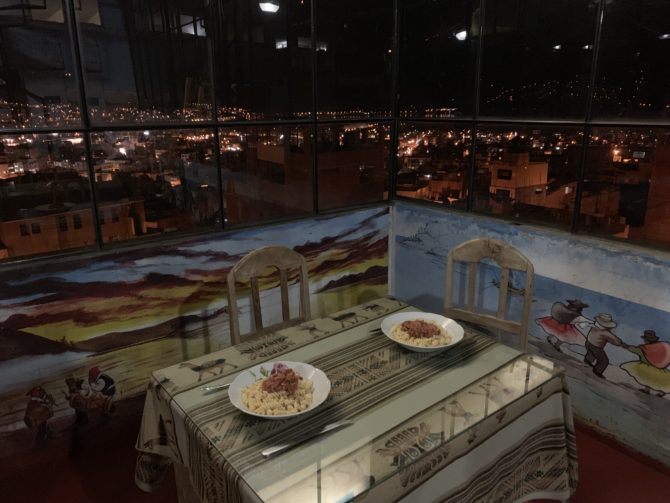
Here’s an embarrassing story: I woke up in the middle of the night to the sound of rain and thunder. But I checked my weather app and it didn’t seem to be either raining or thunderstorming, so I was really freaked out for a moment before Randi stuck her head out of the window and confirmed that it was actually raining. Millennials are the worst.
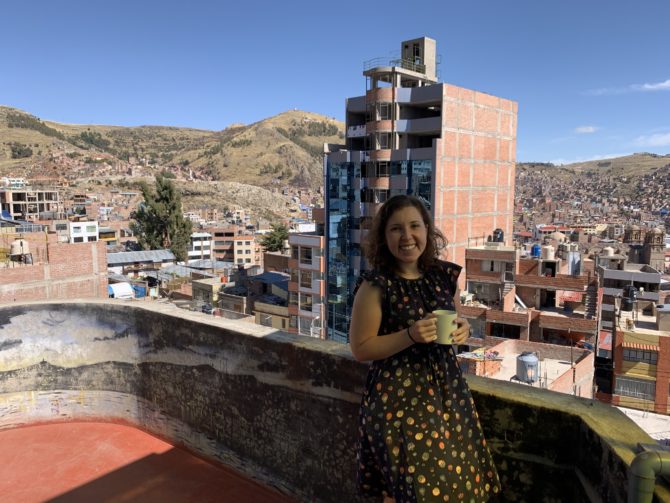
Having not died from perfectly ordinary rain, this morning we bought our next set of bus tickets for tonight’s journey to Tacna and then walked to Puno’s (pretty and very green) main square before settling down in the corner of a wonderful café to swap photos and write our blogs. Even Lima feels like a long time ago now, and it’s good to have a quiet day of recuperation (and WiFi 😉 ) before the next leg.
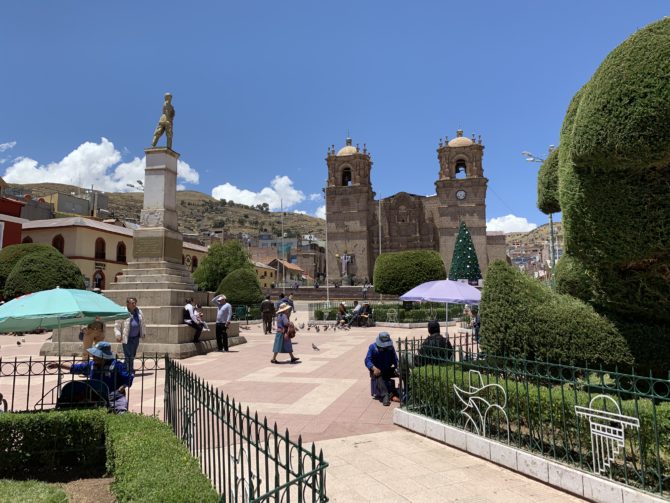
We’ve just arrived back at our AirBnb on our final night in Lima, so it’s time to get comfy on the balcony and reflect on the first stop of our adventures. I arrived on Monday night after a short hop to Madrid and then a much longer flight to Peru, during which I watched King of Thieves – which is basically a much duller version of Ocean’s 8 but with geriatric men. Randi was a few hours behind me, although after 24 hours of not sleeping I have to admit that I just failed to stay awake for her arrival.
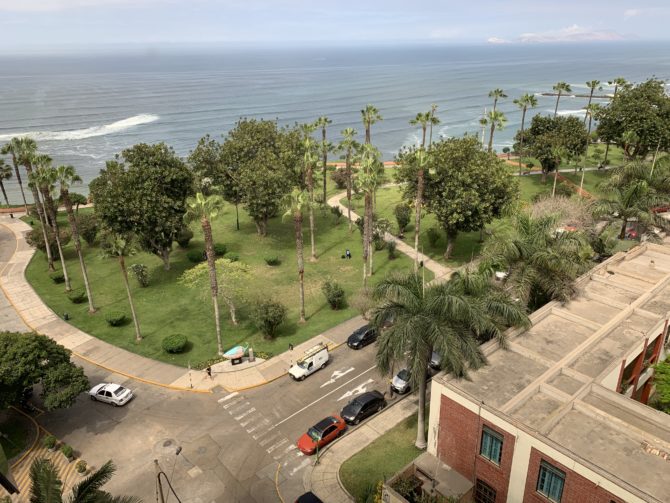
Lima is large, but we confined our explorations to three areas: Miraflores (the swanky and upmarket district where we were staying), the hipster and incredibly photogenic Barranco District and the central, historic core which was about 40 minutes away from us. On our first afternoon, we caught the ‘Metropolitano’ into the centre for a walking tour. The Metropolitano is basically a bus in disguise as a train. It has train-like stations with line maps and turnstiles and platform doors, but behind those doors it’s just a big bus, albeit running in a dedicated bus lane. It’s almost like someone took the city’s money, promised to build them a subway and then skimped on construction.
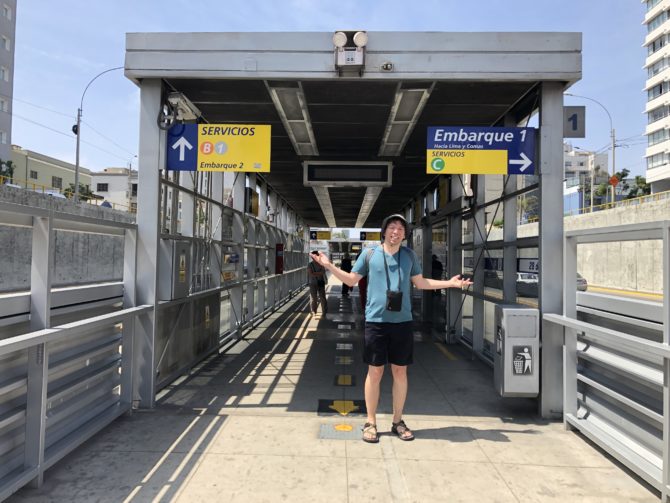
It was only around 2 in the afternoon, but the bus was jam-packed. And in the midst of it all… my phone vanished. Realistically, I was expecting this to happen at some point on our travels – just not on the first day! As soon as I realised it was missing everyone around us on the bus sprung into action, offering their own phones as torches to search the floor and to call my number. But it was definitely gone, and so the plan for our day shifted from “walking tour” to “get a police report for a stolen phone”.
Now, obviously I’d prefer not to have had my phone stolen. But I have to say, the resulting couple of hours were fascinating and surreal. A security guard at the station, Ana, was just coming off her shift and offered to take us to the police station. She then stayed with us for hours as our personal translator and support, which was so incredibly generous of her and hard to imagine happening in other places. We love Ana, and wouldn’t have gotten anywhere without her. She’s still sending us best wishes for our trip over WhatsApp.
The police were friendly enough but somewhat confusing, repeatedly shuffling us between rooms until we manged to explain that we really just needed a report for insurance purposes. They then ushered us into the back of a police car so that two officers could drive us slowly around the centre of Lima, writing – by hand – a lengthy description of the case. We weren’t quite sure where we were going (were we being arrested, perhaps?) but then we arrived at the tourism police station (right next to counter-terrorism) so that they could take over and type it all out again. Finally, after some more waiting and wandering, we got our printed report with the magic stamps of officialdom, and were free to go find me a new phone.
There are no Apple stores in Lima, but there is an authorised reseller (iShop) and getting my hands on a replacement device was no problem. Getting a Peruvian SIM card was… slightly more challenging, as all of the mobile companies have arranged their stores like old-fashioned banks with take-a-number-and-wait ticketing systems, clerks behind booths who need your passport at the first opportunity and lots of unnecessary photocopying. In fairness, my wrangling with T-Mobile afterwards was much worse. But after a couple of days of patiently working out loopholes in their systems, I managed to get my phone restored to more-or-less where it was.
I feel a little bad writing so much about this, because it in no way dampened my enjoyment of Lima as a city and we still got to see everything we had planned. We just got the back of a police car thrown in as an unexpected bonus.
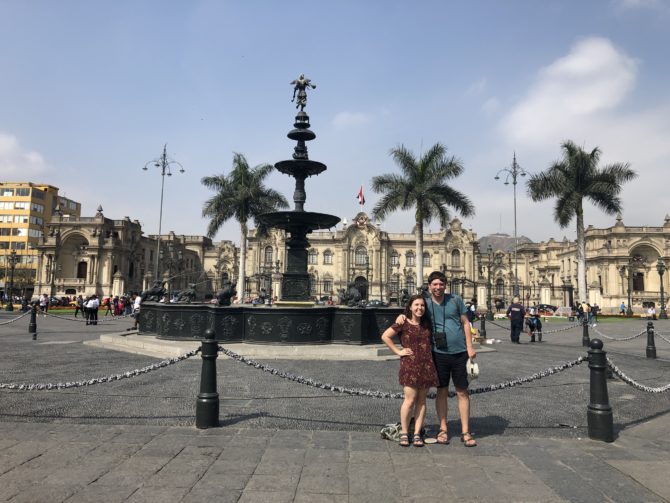
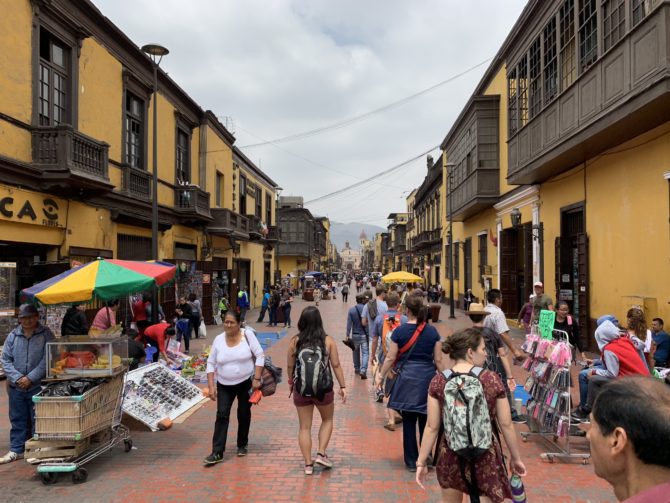
The next day we defiantly took the Metropolitano again (holding our bags a little tighter this time) and finally got to do our walking tour. The central plaza reminded me very much of Quito, and our guide was largely factual although would occasionally spin off down some interesting paths, e.g. “the British are great because they built lots of trains” (sure) and “Peru has a lot of money but we can’t just give people money because you need to teach a man to fish” (hmm). He also promised that a real subway is on the way, although it was pushed back a couple of years due to corruption issues.
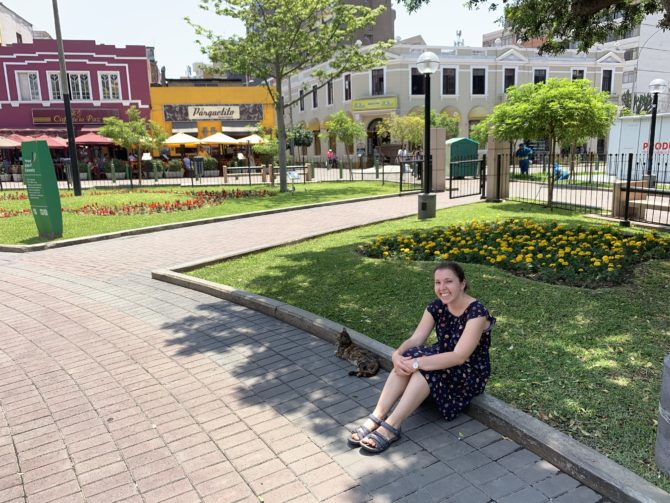
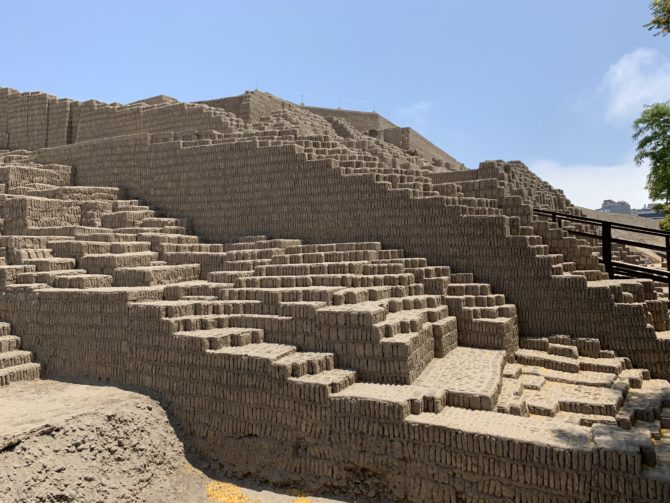

Today we stayed in Miraflores and visited the cats of Kennedy Park (Emily Ray would have an absolute field day) and the Huaca Pucllana, a giant clay and adobe pyramid built between 400 and 700 CE which seems to rise up out of nowhere in the middle of a lovely and well-to-do residential area. It was largely a temple (yes, the kind of temple with human sacrifices) with a large ‘administrative area’ attached, which I can only assume was necessary for the filing of reports and issuance of proto-SIM cards.
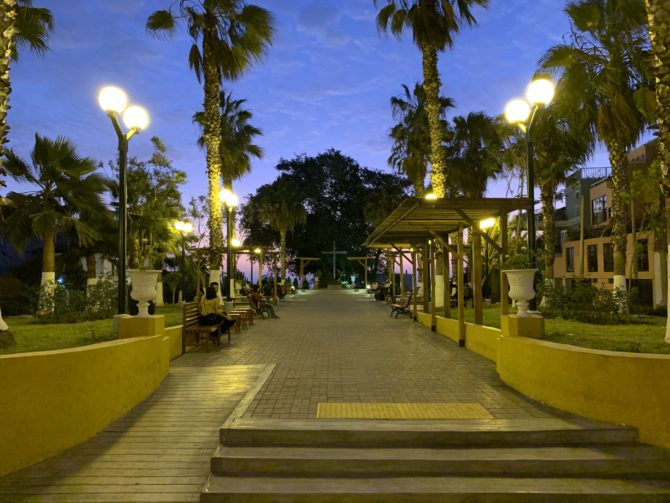
Finally, tonight we walked down the ocean path to dinner in the Barranco District. I know I described it as ‘hipster’ earlier but it almost had an ‘enchanted tree’ vibe, especially by the light of the setting sun. Having successfully got my phone back to a good spot this morning I was in an excellent mood, and I’m so glad we were able to start our journeys here in this great city.

If you’re looking for the most magical place to be for the first light of Christmas Day, I can attest that it’s definitely not inside an Avianca plane cabin. (For one thing, there are a noticeable lack of chimneys for Father Christmas to use.) But I gladly took the sacrifice when it meant arriving in Cusco on Christmas morning. The capital of the Incan Empire, Inc. for several hundred years before the Spanish arrived, and now in modern-day Peru, Cusco is nestled between mountains at an altitude of 3400m and the very first thing a hotel will give you at check-in – literally before a room key – is a cup of coca leaf tea to help with any altitude sickness. (Fact: the majority of the Wikipedia article on coca tea is dedicated to comparing this to a line of cocaine.)
So we took our first couple of days in Cusco relatively easy, trying alpaca meat (tough and chewy) and Ají de Gallina (absolutely delicious) and pondering why all of the ‘stray’ dogs looked so well fed. (Turns out they’re not stray at all, they just wander freely.) We also took a city tour which included the Incan sites of Coricancha and Saksaywaman, but mostly we prepared for the main event: our four-day Lares Trek with Lorenzo Expeditions.
Amazingly, we were the only people on the expedition… not including our (amazing) guide, Bruno. Or our personal chef Andrés, who made actual magic happen several times a day. Or the two guys who led the horses carrying all of our stuff. Or the dog which spontaneously came along for one of the day hikes. So, OK, maybe we were pampered. But it was still the most adventurous holiday I’ve had, passing through remote Andean mountain villages at a rising altitude until we reached a summit of 4400m and I checked to see if I could still breathe any oxygen. (No such problems for any other adults, or the children who came running at the promise of sweets, or the llamas merrily skipping from hill to hill. Sigh.)
It was all so beautiful, and all the effort so worthwhile, in a way which I really can’t capture well enough on this blog. The only experience I wouldn’t recommend to others is camping during a lightning storm, which terrified my wussy self deep into a sleeping bag for hours until it finally stopped. (Surely you shouldn’t be able to see the flashes with your eye closed?)
By the time we arrived at the town of Aguas Calientes (by train!) we felt very little pressure about our visit to Machu Picchu the next morning. Everything had already been so breathtaking that ticking off this most-hyped of tourist destinations would just be the icing on the cake, although it’s fair to say that Bruno didn’t share our relaxed attitude and herded us onto the very first bus up the hill at ridiculous am. Also – and this will sound stupid – I don’t think I ever really thought about what Machu Picchu actually was beyond ‘that one photo’ which everyone takes (mine is below, don’t worry). So, expectations nicely lowered, it was even more wonderful to be led around this incredible Incan citadel in the early morning mist.
A huge thank you to Francisco, who heard about this trip in the planning stage and insisted I book tickets to climb Wayna Picchu too. The stairs were sometimes steep, but behind me was a young American girl who was singing patriotic American songs and wondering loudly if she was the youngest person ever to reach the top, which gave me a great incentive to keep going and never ever turn back. (I promised Savanna I would include my somewhat petulant dig at this perfectly innocent child in this post, which only exposes my ungenerous spirit.) Anyway, the view from the top is suitably fantastic. If you go to Machu Picchu you should do this too.
If you’re looking to rev up a party atmosphere on New Year’s Eve, an Avianca plane cabin is again the wrong choice. But arrive in Quito, Ecuador and you will witness a plethora of New Year festivities on the ride back from the airport: men dressed enthusiastically as women, effigies of the old year ready to burn and – somewhat alarmingly – masked children blockading the street with skipping ropes until they are paid off for their ‘dancing’. (The dancing seemed to be mostly nominal – I think it was all about the blockades.) After a quick recce around the historical centre and danced (well, Randi danced) to the rumba music, we partied hard until the early hours went to bed at 8am.
Most of my advance reading about Quito was of the ‘how to get mugged in the street’ variety, but we had no trouble at all in our (admittedly limited) walks around the small historic district. Quito is really huge in total, however, and the best way to appreciate this is by riding the TelefériQo gondola lift up to the top of the volcano which overlooks the city. You can also hike around in the clouds up here, which was a fine way to spend the first morning of 2017. The next day we learnt more about the history of the city through another walking tour, including a lesson in chocolate making and the weekly changing of the guards in the main square. The President was supposed to come out and wave from the balcony of the Presidential palace at this point, but he failed to make an appearance. Typical Ecuadorian elite.
I could go on and on about my first trip to South America, but I’ll stop before I get too sad about being back. tldr: it was great. You should go. Go right now.

